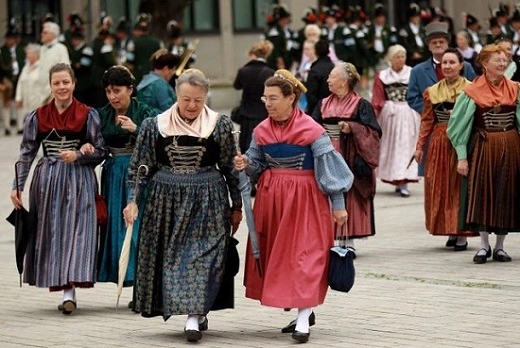Latest Customizations in Lederhosen Fashion Trends
Lederhosen, the classic German attire, has undergone a remarkable transformation since its inception in the 18th century. The evolution is from typical traditional wear to a symbol of cultural pride with a global fashion appeal. This iconic evolution tells the tale of changing times and is a testament to modern customizations. In this article, Latest Customizations in Lederhosen Fashion Trends.

Transformation of Lederhosen Styles Over the Years
Thinking back to the days when the original Lederhosen was introduced, it has embraced various changes. Each customization in traditional lederhosen costume reflects societal norms, tech advancement, and German fashion trends.
The traditional attire has been reinvented, from variation in the material used for Lederhosen making to the color selection, or adding an embroidery element following modernized cuts. The new version of the original Lederhosen offers a personalized touch that resonates with contemporary fashion trends while holding its rich historical essence.
Variations In Material
Traditionally, Lederhosen for men was made from genuine leather, making it ideal for outdoor activities. However, with the cultural shift, traditional Lederhosen has also been influenced by the latest fashion trends and societal values.
With growing awareness and concern for animal rights and sustainable fashion, faux leather has emerged as a popular alternative for Lederhosen. Faux leather can be made from various materials, including polyurethane (PU), offering a cruelty-free option that retains traditional leather’s look and feel.
Color Diversity
Lederhosen was predominantly found in natural leather hues – primarily shades of brown and black. However, in recent years, there’s been a notable shift towards introducing more varied and vibrant colors in Lederhosen designs. Introducing modern and customized Lederhosen has made it more adaptable to different occasions.
This change is primarily driven by fashion trends and the desire to personalize traditional attire. Considering the modern-day color palette, brighter shades have been introduced to lederhosen designs such as red, gray, and other conventional hues.
Embroidery & Detailing
Traditionally, the embroidery on Lederhosen has been a hallmark of craftsmanship. These motifs are not just decorative; they often hold cultural significance, with patterns that may include alpine flowers, oak leaves, or edelweiss.
In today’s world, these motives have been changed to abstract designs that make significant personal choices. This adaptation appeals to younger audiences or those with a taste for fusion. This trend has given birth to new embroidery techniques and materials like multicolored thread, metallic threads, and crystals for a more luxurious look.
Fit & Cuts
Talking about the traditional lederhosen fit & cut, they were designed with highly durable material perfect for physical activities. With time, the modern fit and cut takes place, and here is how it changed;
- Slimmer and tailored fit – This tailored fit is designed to contour more closely to the body, providing a sleek and contemporary silhouette.
- Shorter lengths – The classic knee-length style has seen variations, with some modern designs featuring shorter lengths. This change caters to current fashion trends and appeals to those seeking more casual and versatile wear, especially in warmer climates or less formal occasions.
- Modern Trousers – Covering the needs of modern men, this includes cargo pants, belt loops, and fabric that is easy to wear on regular days.
Accessories
The way Lederhosen is styled has evolved. Traditionally, it was worn with specific accompaniments like a checkered shirt, alpine socks, sturdy shoes, and a Tyrolean hat.
Modern interpretations might pair them with trendy shirts and casual footwear like sneakers or even incorporate contemporary accessories like fashionable belts, hats, or sunglasses.
Accessories play a crucial role in modernizing Lederhosen. Fashionable belts, often with ornate or stylish buckles, replace the classic, simple leather belts. Similarly, hats are no longer limited to the traditional Alpine styles; contemporary options like fedoras or even baseball caps are sometimes used to add a modern twist.
Women’s Lederhosen
Traditionally, Lederhosen for men was common, particularly in Bavaria and the Alpine regions. They were designed for practicality and durability, catering to the needs of workers. Women typically wore Dirndl dresses, a traditional dress with a bodice, blouse, full skirt, and apron.
A major cultural shift has been made as women are seen wearing Lederhosen, breaking the traditional norms. They are specially designed to cater to the female body. Also, the leather made is soft compared to men’s Lederhosen. For the accessories part, women can pair it with trendy blouses, stylish boots, and chic belts.
Conclusion
The evolution of Lederhosen fashion trends with personalizations is a remarkable example of how cultural attire can adapt and thrive in the modern world. Lederhosen has successfully transitioned from traditional German wear to a globally recognized symbol of fashion and cultural pride by embracing new materials, colors, designs, and styles while still honoring its rich heritage.
Frequently Asked Questions
What are the components of an authentic Lederhosen?
The traditional Lederhosen are made up of leather. However, all variations have two side pockets: a one-hip pocket, a knife pocket, and a code piece.
How to look good in Lederhosen?
The German outfit models and designers opt for a comfortably loose shirt with traditional decorative stitching to enhance the appearance in Lederhosen. Choose premium quality authentic Lederhosen and style it with the latest fashion accessories.
- You may love to read: 10 Benefits of Following Fashion Trends
- How Pants became a Fashion trend for Women
- Latest Fashion Trends in India 2024: A Comprehensive Guide
